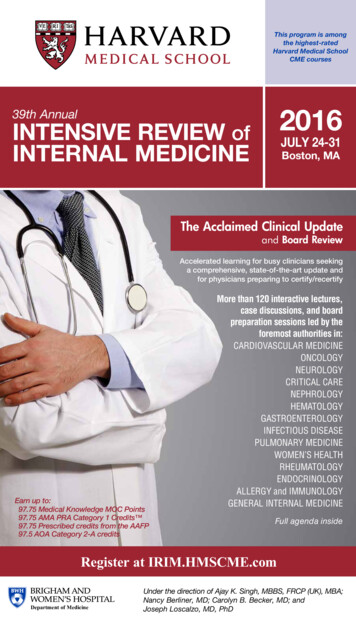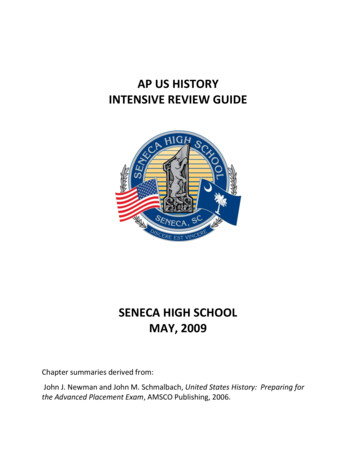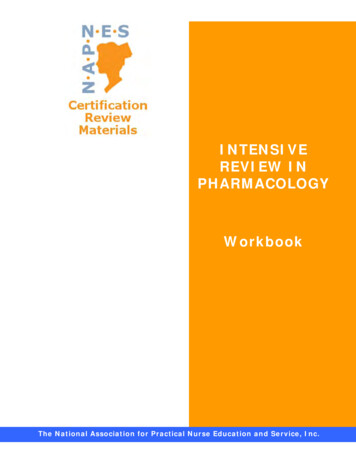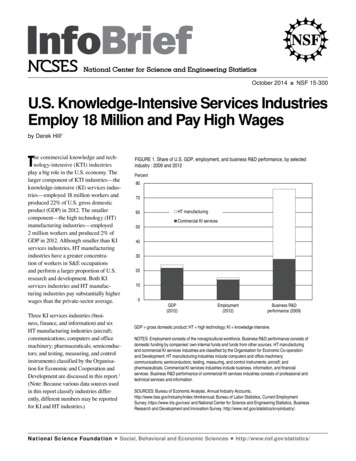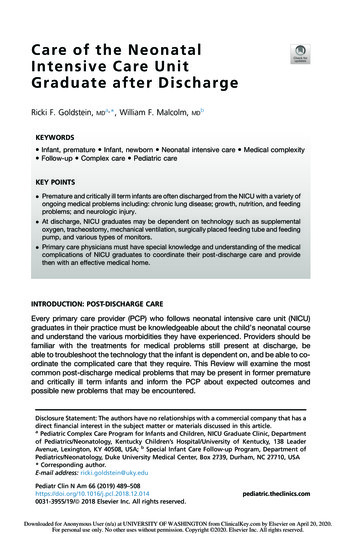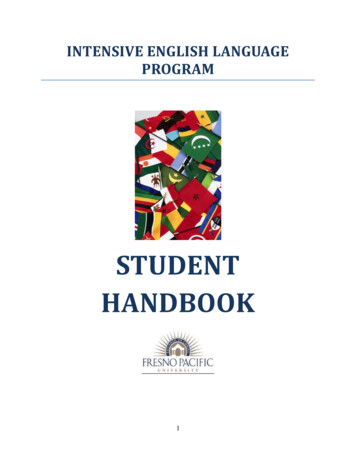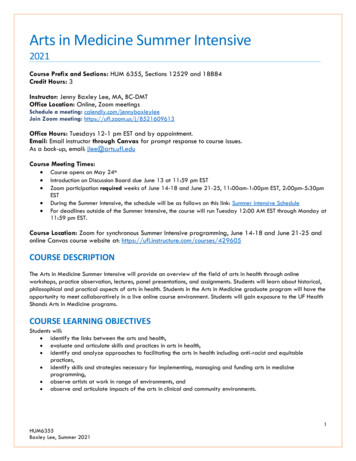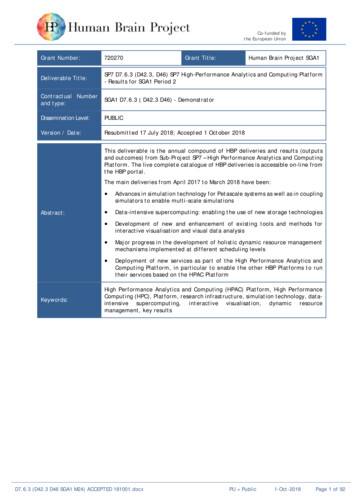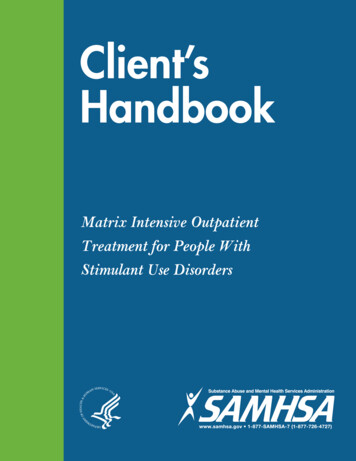
Transcription
Client’sHandbookMatrix Intensive OutpatientTreatment for People WithStimulant Use Disorders
This page intentionally left blank
Client’s HandbookMatrix Intensive Outpatient Treatment forPeople With Stimulant Use DisordersU.S. DEPARTMENT OF HEALTH AND HUMAN SERVICESSubstance Abuse and Mental Health Services AdministrationCenter for Substance Abuse Treatment5600 Fishers LaneRockville, MD 20857
AcknowledgmentsThis publication was developed with support from the University of California at Los Angeles (UCLA) CoordinatingCenter through Grant No. TI11440. The Methamphetamine Treatment Project was funded by the Center forSubstance Abuse Treatment (CSAT), Substance Abuse and Mental Health Services Administration (SAMHSA),U.S. Department of Health and Human Services (HHS). The research was conducted from 1998 to 2002 incooperation with the following institutions: County of San Mateo, San Mateo, CA (TI11411); East Bay RecoveryProject, Hayward, CA (TI11484); Friends Research Institute, Inc., Concord, CA (TI11425); Friends ResearchInstitute, Inc., Costa Mesa, CA (TI11443); Saint Francis Medical Center of Hawaii, Honolulu, HI (TI11441); SanDiego Association of Governments, San Diego, CA (TI11410); South Central Montana Regional Mental HealthCenter, Billings, MT (TI11427); and UCLA Coordinating Center, Los Angeles, CA (TI11440). The publicationwas produced by JBS International, Inc. (JBS), under Knowledge Application Program (KAP) contract numbers270-99-7072 and 270-04-7049 with SAMHSA, HHS. Christina Currier served as the CSAT Government ProjectOfficer. Andrea Kopstein, Ph.D., M.P.H., served as the Deputy Government Project Officer. Cheryl Gallagher,M.A., served as CSAT content advisor.DisclaimerThe views, opinions, and content of this publication are those of the authors and do not necessarily reflect theviews, opinions, or policies of SAMHSA or HHS.Public Domain NoticeAll materials appearing in this publication except those taken from copyrighted sources are in the public domain andmay be reproduced or copied without permission from SAMHSA. Citation of the source is appreciated. However,this publication may not be reproduced or distributed for a fee without the specific, written authorization of the Officeof Communications, SAMHSA, HHS.Electronic Access and Printed CopiesThis publication may be ordered or downloaded from SAMHSA’s Publications Ordering webpage athttp://store.samhsa.gov. Or, please call SAMHSA at 1-877-SAMHSA-7 (1-877-726-4727) (English and Español).Recommended CitationCenter for Substance Abuse Treatment. Client’s Handbook: Matrix Intensive Outpatient Treatment for PeopleWith Stimulant Use Disorders. HHS Publication No. (SMA) 15-4154. Rockville, MD: Substance Abuse and MentalHealth Services Administration, 2006.Originating OfficeQuality Improvement and Workforce Development Branch, Division of Services Improvement, Center forSubstance Abuse Treatment, Substance Abuse and Mental Health Services Administration, 5600 Fishers Lane,Rockville, MD 20857.HHS Publication No. (SMA) 15-4154First Printed 2006Revised 2007, 2008, 2009, 2010, 2011, 2012, 2013, 2014, 2015, and 2017No substantive revisions have been made to this publication since its original printing.
ContentsIntroduction . . . . . . . . . . . . . . . . . . . . . . . . . . . . . . . . . . . . . . . . . . . . . . . . . . . . . . . . . . . . . . . . . . . . .1Individual/Conjoint Session HandoutsIC 1—Sample Service Agreement and Consent . . . . . . . . . . . . . . . . . . . . . . . . . . . . . . . . . . . . 3IC 2A—Recovery Checklist . . . . . . . . . . . . . . . . . . . . . . . . . . . . . . . . . . . . . . . . . . . . . . . . . . . . 5IC 2B—Relapse Analysis Chart . . . . . . . . . . . . . . . . . . . . . . . . . . . . . . . . . . . . . . . . . . . . . . . . 6IC 3A—Treatment Evaluation . . . . . . . . . . . . . . . . . . . . . . . . . . . . . . . . . . . . . . . . . . . . . . . . . . 7IC 3B—Continuing Treatment Plan . . . . . . . . . . . . . . . . . . . . . . . . . . . . . . . . . . . . . . . . . . . . . . 9Early Recovery Skills HandoutsSCH 1—The Importance of Scheduling . . . . . . . . . . . . . . . . . . . . . . . . . . . . . . . . . . . . . . . . . 11SCH 2—Daily/Hourly Schedule . . . . . . . . . . . . . . . . . . . . . . . . . . . . . . . . . . . . . . . . . . . . . . . . 12CAL 1—Marking Progress . . . . . . . . . . . . . . . . . . . . . . . . . . . . . . . . . . . . . . . . . . . . . . . . . . . . 13CAL 2—Calendar . . . . . . . . . . . . . . . . . . . . . . . . . . . . . . . . . . . . . . . . . . . . . . . . . . . . . . . . . . 14ERS 1A—Triggers . . . . . . . . . . . . . . . . . . . . . . . . . . . . . . . . . . . . . . . . . . . . . . . . . . . . . . . . . . 15ERS 1B—Trigger–Thought–Craving–Use . . . . . . . . . . . . . . . . . . . . . . . . . . . . . . . . . . . . . . . . 16ERS 1C—Thought-Stopping Techniques . . . . . . . . . . . . . . . . . . . . . . . . . . . . . . . . . . . . . . . . 17ERS 2A—External Trigger Questionnaire . . . . . . . . . . . . . . . . . . . . . . . . . . . . . . . . . . . . . . . . 19ERS 2B—External Trigger Chart . . . . . . . . . . . . . . . . . . . . . . . . . . . . . . . . . . . . . . . . . . . . . . . 20ERS 3A—Internal Trigger Questionnaire . . . . . . . . . . . . . . . . . . . . . . . . . . . . . . . . . . . . . . . . 21ERS 3B—Internal Trigger Chart . . . . . . . . . . . . . . . . . . . . . . . . . . . . . . . . . . . . . . . . . . . . . . . 22ERS 4A—12-Step Introduction . . . . . . . . . . . . . . . . . . . . . . . . . . . . . . . . . . . . . . . . . . . . . . . . 23ERS 4B—The Serenity Prayer and the 12 Steps of Alcoholics Anonymous . . . . . . . . . . . . . 28ERS 5—Roadmap for Recovery . . . . . . . . . . . . . . . . . . . . . . . . . . . . . . . . . . . . . . . . . . . . . . . 29ERS 6A—Five Common Challenges in Early Recovery . . . . . . . . . . . . . . . . . . . . . . . . . . . . . 32ERS 6B—Alcohol Arguments . . . . . . . . . . . . . . . . . . . . . . . . . . . . . . . . . . . . . . . . . . . . . . . . . 34ERS 7A—Thoughts, Emotions, and Behavior . . . . . . . . . . . . . . . . . . . . . . . . . . . . . . . . . . . . . 35ERS 7B—Addictive Behavior . . . . . . . . . . . . . . . . . . . . . . . . . . . . . . . . . . . . . . . . . . . . . . . . . 36ERS 8—12-Step Sayings . . . . . . . . . . . . . . . . . . . . . . . . . . . . . . . . . . . . . . . . . . . . . . . . . . . . 37Relapse Prevention HandoutsRP 1—Alcohol . . . . . . . . . . . . . . . . . . . . . . . . . . . . . . . . . . . . . . . . . . . . . . . . . . . . . . . . . . . . . 39RP 2—Boredom . . . . . . . . . . . . . . . . . . . . . . . . . . . . . . . . . . . . . . . . . . . . . . . . . . . . . . . . . . . 41iii
Client’s Handbook: Matrix Intensive Outpatient TreatmentRP 3A—Avoiding Relapse Drift . . . . . . . . . . . . . . . . . . . . . . . . . . . . . . . . . . . . . . . . . . . . . . . . 43RP 3B—Mooring Lines Recovery Chart . . . . . . . . . . . . . . . . . . . . . . . . . . . . . . . . . . . . . . . . . 45RP 4—Work and Recovery . . . . . . . . . . . . . . . . . . . . . . . . . . . . . . . . . . . . . . . . . . . . . . . . . . . 46RP 5—Guilt and Shame . . . . . . . . . . . . . . . . . . . . . . . . . . . . . . . . . . . . . . . . . . . . . . . . . . . . . 48RP 6—Staying Busy . . . . . . . . . . . . . . . . . . . . . . . . . . . . . . . . . . . . . . . . . . . . . . . . . . . . . . . . 50RP 7—Motivation for Recovery . . . . . . . . . . . . . . . . . . . . . . . . . . . . . . . . . . . . . . . . . . . . . . . . 52RP 8—Truthfulness . . . . . . . . . . . . . . . . . . . . . . . . . . . . . . . . . . . . . . . . . . . . . . . . . . . . . . . . . 54RP 9—Total Abstinence . . . . . . . . . . . . . . . . . . . . . . . . . . . . . . . . . . . . . . . . . . . . . . . . . . . . . 56RP 10—Sex and Recovery . . . . . . . . . . . . . . . . . . . . . . . . . . . . . . . . . . . . . . . . . . . . . . . . . . . 57RP 11—Anticipating and Preventing Relapse . . . . . . . . . . . . . . . . . . . . . . . . . . . . . . . . . . . . . 58RP 12—Trust . . . . . . . . . . . . . . . . . . . . . . . . . . . . . . . . . . . . . . . . . . . . . . . . . . . . . . . . . . . . . . 61RP 13—Be Smart, Not Strong . . . . . . . . . . . . . . . . . . . . . . . . . . . . . . . . . . . . . . . . . . . . . . . . . 62RP 14—Defining Spirituality . . . . . . . . . . . . . . . . . . . . . . . . . . . . . . . . . . . . . . . . . . . . . . . . . . 64RP 15—Managing Life; Managing Money . . . . . . . . . . . . . . . . . . . . . . . . . . . . . . . . . . . . . . . . 66RP 16—Relapse Justification I . . . . . . . . . . . . . . . . . . . . . . . . . . . . . . . . . . . . . . . . . . . . . . . . 68RP 17—Taking Care of Yourself . . . . . . . . . . . . . . . . . . . . . . . . . . . . . . . . . . . . . . . . . . . . . . . 70RP 18—Emotional Triggers . . . . . . . . . . . . . . . . . . . . . . . . . . . . . . . . . . . . . . . . . . . . . . . . . . . 71RP 19—Illness . . . . . . . . . . . . . . . . . . . . . . . . . . . . . . . . . . . . . . . . . . . . . . . . . . . . . . . . . . . . . 73RP 20—Recognizing Stress . . . . . . . . . . . . . . . . . . . . . . . . . . . . . . . . . . . . . . . . . . . . . . . . . . 75RP 21—Relapse Justification II . . . . . . . . . . . . . . . . . . . . . . . . . . . . . . . . . . . . . . . . . . . . . . . . 76RP 22—Reducing Stress . . . . . . . . . . . . . . . . . . . . . . . . . . . . . . . . . . . . . . . . . . . . . . . . . . . . . 78RP 23—Managing Anger . . . . . . . . . . . . . . . . . . . . . . . . . . . . . . . . . . . . . . . . . . . . . . . . . . . . . 80RP 24—Acceptance . . . . . . . . . . . . . . . . . . . . . . . . . . . . . . . . . . . . . . . . . . . . . . . . . . . . . . . . 81RP 25—Making New Friends . . . . . . . . . . . . . . . . . . . . . . . . . . . . . . . . . . . . . . . . . . . . . . . . . 82RP 26—Repairing Relationships . . . . . . . . . . . . . . . . . . . . . . . . . . . . . . . . . . . . . . . . . . . . . . . 83RP 27—Serenity Prayer . . . . . . . . . . . . . . . . . . . . . . . . . . . . . . . . . . . . . . . . . . . . . . . . . . . . . 84RP 28—Compulsive Behaviors . . . . . . . . . . . . . . . . . . . . . . . . . . . . . . . . . . . . . . . . . . . . . . . . 85RP 29—Coping With Feelings and Depression . . . . . . . . . . . . . . . . . . . . . . . . . . . . . . . . . . . 88RP 30—12-Step Programs . . . . . . . . . . . . . . . . . . . . . . . . . . . . . . . . . . . . . . . . . . . . . . . . . . . 91RP 31—Looking Forward; Managing Downtime . . . . . . . . . . . . . . . . . . . . . . . . . . . . . . . . . . . 95RP 32—One Day at a Time . . . . . . . . . . . . . . . . . . . . . . . . . . . . . . . . . . . . . . . . . . . . . . . . . . 98RP 33—Drug Dreams During Recovery . . . . . . . . . . . . . . . . . . . . . . . . . . . . . . . . . . . . . . . . 100RP Elective A—Client Status Review . . . . . . . . . . . . . . . . . . . . . . . . . . . . . . . . . . . . . . . . . . 101RP Elective B—Holidays and Recovery . . . . . . . . . . . . . . . . . . . . . . . . . . . . . . . . . . . . . . . . 103RP Elective C—Recreational Activities . . . . . . . . . . . . . . . . . . . . . . . . . . . . . . . . . . . . . . . . . 105iv
IntroductionWelcomeYou have taken a big step by deciding to come into treatment. You should be veryproud of your decision to enter treatment and your commitment to recovery.This is your Client’s Handbook. It contains most of the handouts you will need for yourtreatment. In this book you will find handouts for three types of sessions: Individual/Conjoint, Early Recovery Skills, and Relapse Prevention. Family Education sessionsalso use handouts. Those handouts will be given to you by your counselor during theFamily Education sessions.Client HandoutsThe handouts in this book will help you get the most out of your Matrix treatment.Some handouts ask questions and have spaces for your answers. Other handouts askyou to read and think about a subject or an idea, or they contain advice or remindersabout recovery. It is a good idea to keep and review the handouts after you have usedthem. They will help you stay strong as you continue in your recovery.During each treatment session, your counselor will ask you to follow along on thehandout while he or she goes over it with the group. The counselor will give you timeto think about what it says and write your answers to questions it may ask. The groupwill then discuss the handout. You should share your thoughts and ask questionsduring this time. If you still have questions, there will be more time to ask questionsduring the last part of each session.Making the Most of Group SessionsThe more work you put into group therapy, the more benefit you will receive from it.Part of the work you should be doing is reading and thinking about the handouts. Butthere are other things you can do to make sure you benefit fully from group therapy:1
Client’s Handbook: Matrix Intensive Outpatient Treatment Attend every group session. Arrive for group sessions on time or a little early. Listen carefully and respectfully to the counselor and the other clients. Be supportive of other clients. If you disagree with someone, be politewhen you speak to him or her. Do not attack people personally. Do not talk about other clients’ personal information outside group. Clientsmust be able to trust one another if they are to feel comfortable sharingtheir thoughts. Think about what you read and about what the counselor and otherclients say. Ask questions when you do not understand something. Participate in group discussions. Do not dominate the conversation. Allow time for other clients to participate. Be honest. After the session is over, think about what you learned and try to applyit to your recovery. Work on the homework assignments that the counselor gives you. (Thehomework assignments are usually an activity. These are different fromthe handouts that you work on during the session.)2
IC 1Sample Service Agreementand Consent[Each program uses an agreement and consent form that it has developed to meet its particular needs.This form is provided as a sample.]It is important that you understand the kinds of services you will be provided and the terms andconditions under which these services will be offered.I, , am requesting treatment from the staff of. As a condition of that treatment, I acknowledgethe following items and agree to them. (Please initial each item.)I understand:1. T he staff believes that the outpatient treatment strategies the program uses provide auseful intervention for chemical dependence problems; however, no specific outcome canbe guaranteed.2. T reatment participation requires some basic ground rules. These conditions are essential fora successful treatment experience. Violation of these rules can result in treatment termination.I agree to the following:a. It is necessary to arrive on time for appointments. At each visit I will be prepared to take urine andbreath-alcohol tests.b. Conditions of treatment require abstinence from all drug and alcohol use for the entireduration of the treatment program. If I am unable to make this commitment, I will discuss othertreatment options with the program staff.c. I will discuss any drug or alcohol use with the staff and group while in treatment.d. Treatment consists of individual and group sessions. Individual appointments can be rescheduled,if necessary. I understand that group appointments cannot be rescheduled and attendance isextremely important. I will notify the counselor in advance if I am going to miss a group session.Telephone notification may be made for last-minute absence or lateness.e. Treatment will be terminated if I attempt to sell drugs or encourage drug use by other clients.f.I understand that graphic stories of drug or alcohol use will not be allowed.1 of 2
IC 1Sample Service Agreementand Consentg. I agree not to become involved romantically or sexually with other clients.h. I understand that it is not advisable to be involved in any business transactions with other clients.i.I understand that all matters discussed in group sessions and the identity of all groupmembers are absolutely confidential. I will not share this information with nonmembers.j.All treatment is voluntary. If I decide to terminate treatment, I will discuss this decision with the staff.3. S taff: Services are provided by psychologists, licensed marriage and family counselors,master’s-level counselors-in-training, or other certified addiction staff people. All nonlicensedcounselors are supervised by a licensed counselor trained in the treatment of addictions.4. C onsent to Videotape/Audiotape: To help ensure the high quality of services provided by theprogram, therapy sessions may be audiotaped or videotaped for training purposes. The clientand, if applicable, the client’s family consent to observation, audiotaping, and videotaping.5. C onfidentiality: All information disclosed in these sessions is strictly confidential and may notbe revealed to anyone outside the program staff without the written permission of the clientor the client’s family. The only exceptions are when disclosures are required or permitted bylaw. Those situations typically involve substantial risk of physical harm to oneself or to othersor suspected abuse of children or the elderly.6. A ccomplishing treatment goals requires the cooperation and active participation of clientsand their families. Very rarely, lack of cooperation by a client may interfere substantiallywith the program’s ability to render services effectively to the client or to others. Under suchcircumstances, the program may discontinue services to the client.I certify that I have read, understand, and accept this Service Agreement and Consent. Thisagreement and consent covers the length of time I am involved in treatment activities atthis facility.Client’s Signature: Date:2 of 2
IC 2ARecovery ChecklistOutpatient treatment requires a great deal of motivation and commitment. To get the mostfrom treatment, it is necessary for you to replace many old habits with new behaviors.Check all the things that you do regularly or have donesince entering treatment: Schedule activities dailyVisit physician for checkupDestroy all drug paraphernaliaAvoid people who use alcoholAvoid people who use drugsAvoid bars and clubsStop using alcoholStop using all drugsPay financial obligations promptlyIdentify addictive behaviors Use thought stopping for cravingsAttend Individual/Conjoint sessionsAttend Early Recovery Skills andRelapse Prevention sessionsAttend 12-Step or mutual-helpmeetingsGet a sponsorExercise dailyDiscuss thoughts, feelings, and behaviors honestly with your counselorAvoid triggers (when possible)What other behaviors have you decided to start since you enteredtreatment?Which behaviors have been easy for you to do?Which behaviors take the most effort for you to do?Which behavior have you not begun yet? What might need to changefor you to begin this behavior?Behavior Not BegunChange Needed1 of 1
1 of 1FeelingsAbout theAboveEventPatterns ofBehaviorSubjectCareerEventsbefore the l RelapseRelatedPatterns ThoughtsBehaviorsHealthStatusinterrupt the relapse. Using the chart below, note events that occurred during the week immediatelyindicate the beginning of a relapse. Identifying your patterns of behavior will help you recognize andA relapse episode does not begin when you take a drug. Often, things that happen before you useName: Date of Relapse:IC 2BRelapse Analysis Chart
1 of 2Financial, tWhere areyou now?Where wouldyou like to be?goals for the areas of life listed in the left column.What steps doyou needto take?When?develop a plan and identify the steps necessary for reaching your goals. Write your current status andtreatment, it is important to set new goals and plan for a different lifestyle. This guide will help youRecovery requires specific actions and behavioral changes in many areas of life. Before you end yourIC 3ATreatment Evaluation
2 of 2DateClient’s SignatureWhat steps doyou needto take?Counselor’s SignatureDateWhen?Where wouldyou like to be?12-Step orMutual-HelpMeetingsLeisure ActivitiesExerciseEducationSubjectWhere areyou now?IC 3ATreatment Evaluation
IC 3BContinuingTreatment PlanRecovery is a lifelong process. You can stop drug andalcohol use and begin a new lifestyle during the first 4 months of treatment. Developing an awareness of what anchors your recovery is an important partof that process. But this is only the beginning of your recovery. As you move forwardwith your recovery after treatment, you will need a lot of support. And you may needdifferent kinds of support than you did during treatment. You and your counselor canuse the information below to help you decide how best to support your recovery.Group WorkYou should participate in at least one regular recoverygroup every week after treatment. The program offers aSocial Support group that meets once a week. Otherrecovery groups are often available in the community.Ask your counselor about local recovery groups.Individual TherapyIndividual sessions with an addiction counselor might be helpful. When your currenttreatment ends, you have choices about continuing with therapy. You may choosethis time to enter therapy with another professional. You may want to return to therapywith the professional who referred you for the Matrix IOP method. Or you may chooseto continue to see your current Matrix IOP counselor.Couples TherapyIt is often a good idea at this point for couples to begin seeing a marriage counselortogether to work on relationship issues.12-Step or Mutual-Help MeetingsAttendance at a 12-Step or mutual-help meeting is a critical part of the recovery process. It is essential to find a meeting that you will attend regularly.1 of 2
IC 3BContinuingTreatment PlanMy plan for the months following treatment is:Client’s SignatureDateCounselor’s SignatureDate2 of 2
SCH 1The Importanceof SchedulingScheduling may be a difficult and boringtask if you’re not used to it. It is, however,an important part of the recovery pro-What If I Am Not an OrganizedPerson?Learn to be organized. Buy a sched-cess. People with substance useule book and work with your counselor.disorders do not schedule their time.Thorough scheduling of your activities isScheduling your time will help youvery important to treating your substanceachieve and maintain abstinence.use disorder. Remember, your rationalbrain plans the schedule. If you followWhy Is Scheduling Necessary?the schedule, you won’t use. Your addict-If you began your recovery in a hospital,ed brain wants to be out of control. If youyou would have the structure of thego off the schedule, your addicted brainprogram and the building to help youmay be taking you back to using drugs orstop using. As a person in outpatientdrinking.treatment, you have to build that structure to help support you as you continuefunctioning in the world. Your scheduleis your structure.Do I Need To Write Down MySchedule?Absolutely. Schedules that are in yourhead are too easily revised. If you writedown your schedule while your rationalbrain is in control and then follow theschedule, you will be doing what youthink you should be doing instead ofwhat you feel like doing.Who Decides What I Schedule?You do! You may consider suggestionsmade by your counselor or family members, but the final decision is yours. Justbe sure you do what you wrote down.Follow your schedule; try not to makeany changes.Most people can schedule a 24-hourperiod and follow it. If you can, you areon your way to gaining control of yourlife. If you cannot, you may need to consider a higher level of care as a start.1 of 1
SCH 2Daily/Hourly ScheduleDate:7:00 AMHow many hours will you sleep?8:00 AMFrom To9:00 AMNotes:10:00 AM11:00 AM12:00 PM1:00 PM2:00 PM3:00 PM4:00 PMReminders:5:00 PM6:00 PM7:00 PM8:00 PM9:00 PM10:00 PM11:00 PM1 of 1
CAL 1Marking ProgressIt is useful for both you and your counselor to know where you are in the recovery process at all times. Marking a calendar as you go helps in several ways: It’s a reminder of how far you’ve come in your recovery. A feeling of pride often results from seeing the number of days you havebeen abstinent. Recovery can seem very long unless you can measure your progress inshort units of time.Make a mark to record on the calendar pages every day of abstinence you achieve.You may decide to continue the exercise following the program.If you record your abstinent days regularly, this simple procedure will help you andyour counselor see your progress.1 of 1
CAL 2CalendarMonth:SUNDAYMONDAYTUESDAYWEDNESDAY1 of 1THURSDAYFRIDAYSATURDAY
ERS 1ATriggerTriggersUseThoughtCravingTriggers are people, places, objects, feelings, and times thatcause cravings. For example, if every Friday night someone cashes a paycheck, goesout with friends, and uses stimulants, the triggers might be Friday night After work Friends who use A bar or club MoneyYour brain associates the triggers with substance use. As a result of constant triggering and using, one trigger can cause you to move toward substance use. The trigger–thought–craving–use cycle feels overwhelming.Stopping the craving process is an important part of treatment. The best way to dothat is to do the following:1.Identify triggers.2.Prevent exposure to triggers whenever possible (for example, do nothandle large amounts of cash).3.Cope with triggers differently than in the past (for example, scheduleexercise and a 12-Step or mutual-help meeting for Friday nights).Remember, triggers affect your brain and cause cravings even though you havedecided to stop substance use. Your intentions to stop must translate into behaviorchanges, which keep you away from possible triggers.What are some of the strongest triggers for you?What particular triggers might be a problem in the near future?1 of 1
ERS 1BTrigger–Thought–Craving–UseThe Losing ArgumentIf you decide to stop drinking or using but at some point end up moving toward usingsubstances, your brain has given you permission by using a process called relapsejustification. Thoughts about using start an argument inside your head—your rationalself versus your substance-dependent self. You feel as though you are in a fight, andyou must come up with many reasons to stay abstinent. Your mind is looking for anexcuse to use again. You are looking for a relapse justification. The argument insideyou is part of a series of events leading to substance use. How often in the past hasyour substance dependence won this argument?Thoughts Become CravingsCraving does not always occur in a straightforward, easily recognized form. Often thethought of using passes through your head with little or no effect. But it’s important toidentify these thoughts and try to eliminate them. It takes effort to identify and stop athought. However, allowing yourself to continue thinking about substance use is choosingto relapse. The further the thoughts are allowed to go, the more likely you are to relapse.The “Automatic” ProcessDuring addiction, triggers, thoughts, cravings, and use seem to run together. However,the usual sequence goes like this:TRIGGER[ THOUGHT[ CRAVING[ USEThought StoppingThe only way to ensure that a thought won’t lead to a relapse is to stop the thoughtbefore it leads to craving. Stopping the thought when it first begins prevents it frombuilding into an overpowering craving. It is important to do it as soon as you realizeyou are thinking about using.1 of 1
Thought-StoppingTechniquesERS 1CA New SequenceTo start recovery, it is necessary to interrupt the trigger–thought–craving–usesequence. Thought stopping provides a tool for disrupting the tinuedThoughtsCravingsUseThis process is not automatic. You make a choice either to continue thinking aboutusing (and start on the path toward relapse) or to stop those thoughts.Thought-Stopping TechniquesTry the techniques described below, and use those that work best for you:Visualization. Imagine a scene in which you deny the power ofthoughts of use. For example, picture a switch or a lever in your mind.Imagine yourself actually moving it from ON to OFF to stop theusing thoughts. Have another picture ready to think about in placeof those thoughts.1 of 2
ERS 1CThought-StoppingTechniquesSnapping. Wear a rubberbandloosely on your wrist. Each time you becomeaware of thoughts of using, snap the rubberbandand say “No!” to the thoughts as you make yourself think about another subject. Have a subjectready that is meaningful and interesting to you.Relaxation. Feelings of hollowness, heaviness, and cramping in the stomach arecravings. These often can be relieved by breathing in deeply (filling lungs with air)and breathing out slowly. Do this three times. You should be able to feel the tightnessleaving your body. Repeat this whenever the feeling returns.Call someone. Talking to another person provides an outlet for your feelings andallows you to hear your thinking process. Have phone numbers of supportive,available people with you always, so you can use them when you need them.ALLOWING THE THOUGHTS TODEVELOP INTO CRAVINGS ISMAKING A CHOICE TO REMAINDEPENDENT ON SUBSTANCES.2 of 2
ERS 2AExternal TriggerQuestionnairePlace a checkmark next to activities, situations, or settings in which you frequently usedsubstances; place a zero next to activities, situations, or settings in which you neverhave used substances. Home aloneHome with friendsFriend’s homePartiesSporting eventsMoviesBars/clubsBeachConcertsWith friends whouse drugsWh
Or, please call SAMHSA at 1-877-SAMHSA-7 (1-877-726-4727) (English and Español). Recommended Citation Center for Substance Abuse Treatment. Client’s Handbook:
